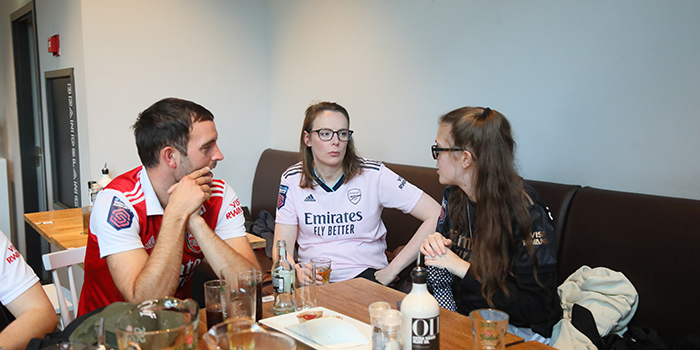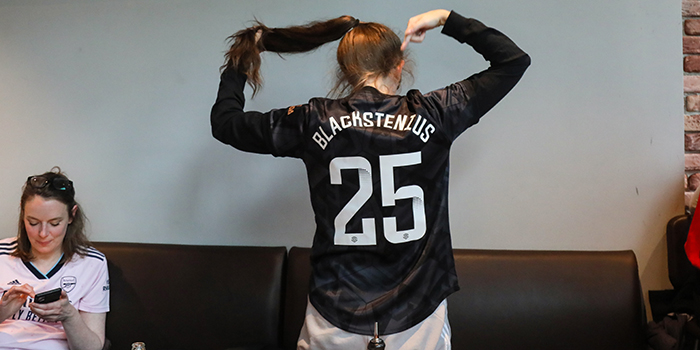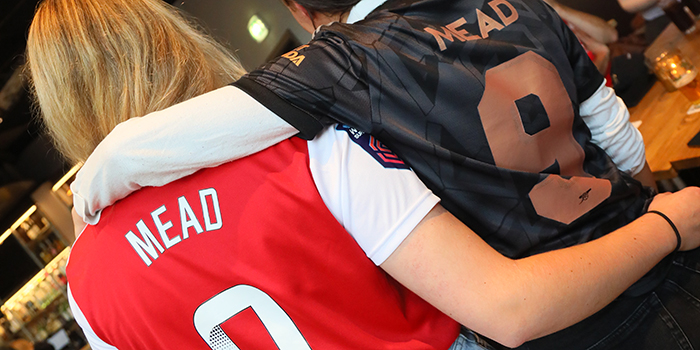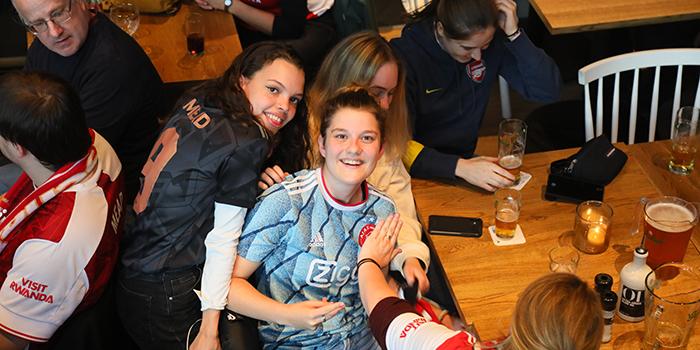Last week, Arsenal Women played Ajax in Amsterdam in the second leg of their Champions League final qualifying round. The previous Saturday, the Gunners had battered Tottenham Hotspur 4-0 at Emirates Stadium in front of 47,000 fans. In May, the same fixture at the same stadium drew around 15,000 supporters.
The obvious multiplier was England’s success at Euro 2022, which the Lionesses won on home soil. In women’s football, international football remains the gateway drug for the club game. While England is experiencing its own boom in crowd numbers, the Netherlands experienced something similar in 2017 when their national team, also named the Lionesses (Oranje Leeuwinnen), also guided by Sarina Wiegman and also playing on home soil, won the previous tournament.
On both of those occasions, Arsenal have benefitted from a flurry of new supporters. The Dutch cast of 2017 contained four Gunners (Sari van Veenendaal, Dominique Janssen, Danielle van de Donk and Vivianne Miedema- only the latter remains at the club), leading to an explosion in Dutch support for Arsenal.
The triumphant England team had three Arsenal players- Lotte Wubben-Moy, captain Leah Williamson and player of the tournament and Golden Boot winner Beth Mead. The upshot is that the majority of Sportpark De Toekomst were decked out in Arsenal shirts last Wednesday.
This was partly because away travel for Arsenal Women games is becoming increasingly popular. The Arsenal Women Supporters Club arrange a meet up in a bar near the stadium and the result is an intoxicating blend of English and Dutch accents, all decked out in Arsenal colours.
Joe Monte has travelled from London for the game and he tells me that away travel for Arsenal Women games is something he has only started doing relatively recently. “Last year, I did every single domestic game. Before that, I had gone to a lot of home games and a handful of away. I had the sense we were building something and when I saw the numbers we had for the Koge away game (in Copenhagen) last season, that was so great. This is what I want us to do, this is how I want it to be.”

Joe says the idea of a nascent community forming around the team has inspired him, “This is where the supporters club has really stepped up, there was a bit of a void and it was hard to make connections. It’s not in my nature to do this but I started to make more of an effort to talk to people at the games too, to try to create that sense of community. I know it’s a safe space to do that.”
What is striking when you talk to women’s football fans is that their routes into the sport are so different from the men’s game. There isn’t the decades and decades of family tradition of going to see women’s teams. People often support different teams across the sexes. Like Cara, originally from Brighton, who also travelled from England for the game.
“I started going to women’s football in 2019 just before the World Cup. I am from Brighton originally, so I was going to the AMEX a lot. The Lionesses played there just before the World Cup, I went, got into the Lionesses through the 2019 World Cup and never looked back. I support the Brighton men’s team but my grandfathers both support Arsenal so I always had a soft spot for them and I went to some men’s games when I was younger.”
One of the barriers for more people coming to women’s football matches is that people often don’t have others to come with. Women’s football is still a rather niche interest area and supporters don’t always know friends or family members to go to games with. “I am a season-ticket holder now at Arsenal Women,” Cara explains. “I have two and I take a different friend every time.
“I don’t really know anyone who likes it enough to come with me to every game but I have enough friends who will come every few months. At the Emirates (for the Spurs game) Arsenal put the season ticket holders together in the same area and now I find myself chatting with people I see at games all the time.”
When we go to watch football, men’s or women’s, it’s not just the game that we come to see. You can see that on television, afterall (certainly with the men’s Premier League, anyway). “I’m not sure whether I would have come without the idea that others were coming too, without some sort of meet up,” Cara admits.
Often, you will find people who used to be fans of men’s football but became disenfranchised or turned off by the hyperbole that surrounds it. “I stopped going to football, I lost interest in it,” Joe admits. “Women’s football got me back into it.” Another one of the key levers for enticing fans is the connection to the players who, firstly, are less removed from the fans on a financial level but also engage with supporters in the aftermath of games, posing for pictures and signing autographs.
Joe argues that he found the culture to be more relatable than men’s football “I found I could invest in these players as players and as people. I gave it a little bit of my time and it’s been massively rewarded. It reminded me of how I felt about football as a kid, that attachment.” However, women’s football can still suffer from a lack of crowd atmosphere.
The sense that the game is important and that it matters to people. Again, that is a significant and oft-ignored factor in assessing the popularity of men’s football. The Premier League capped the price of away tickets because they absolutely consider the noise and the colour to be a central part of the spectacle and that is usually spurred by away fans.

Amy has also travelled over from London for the game and goes to nearly every Arsenal Women game now having become a fan of women’s football after the 2019 World Cup. “It adds a different dimension to have so many friends here and not just friends, but people who know women’s football. It’s no different to people going to away games for men’s football I imagine, that feeling of being together with people who are there for the same reason as you.”
Joe says he wants to help develop that burgeoning atmosphere at games, which will surely arrive as people become more familiar with their surroundings. There is also a keenness in women’s football that it doesn’t descend into some of the more intimidating aspects seen in elite men’s football. Joe also wants to help continue the legacy of Maria Petri, Arsenal Women’s most recognisable (and audible) fan, who sadly passed away recently.
“I sit in the East Stand near where Maria (Petri) sat and everyone loved her there,” Joe explains. “I think a lot of us didn’t want to go above her either when it came to chanting. This year, I started to speak to a group who sit near me and I get the sense that we all want to sing. I am quite shy but I said to them, ‘I am willing to go first if that gives them the confidence to join me.’”
I speak to an old friend at the bar, John Williamson who, I am going to venture, has an unmatched attendance record for Arsenal games across the men’s, women’s and youth teams. For John, he is here for the same reason he always is, to see Arsenal. But he is witnessing a growth in the numbers of people travelling to Arsenal Women away matches.
John travelled to Sweden in 2007 for the first leg of the 2007 UEFA Cup Final against Umea. He missed the men’s North London derby at White Hart Lane for it. John reflects on how much things have changed since the Gunners won the tournament. “I don’t even think a lot of the player’s parents were there. I travelled with Lianne Sanderson’s (former Arsenal player) family and I think we were basically the only ones from England in the seats.”
Arsenal’s men’s team have a truly international fan base and, obviously, there is a desire to piggyback onto that with the women’s team. One region where Arsenal Women absolutely have their own following and culture is the Netherlands, where the Gunners face off against Ajax. With four senior, popular Arsenal players in the Dutch Euro 2017 winning squad, Arsenal became the team of choice for lots of Dutch supporters.
However, it was really the 2019 World Cup that blew that particular border down. “It was after the 2019 World Cup, I watched the Dutch team and all my favourite players played for Arsenal,” Micki, a Dutch Arsenal fan tells me. “I supported the Dutch team before that; but I wasn’t into club football at all, just the Netherlands. After that World Cup, I didn’t want it to end so I needed a club team and I just fell in love with Arsenal.”
Sophie, from Utrecht, had a similar induction. “I started just after the 2019 World Cup, just like Micki, mainly because of DvD (Danielle van de Donk). I was supporting the Dutch girls and when the 2019 season started, I started supporting Arsenal Women.” So why the two-year delay between the Euro 2017 triumph and the connection with Arsenal?

“I watched the Dutch girls win the Euros in 2017 but there was no way to watch the WSL then,” Sophie explains. “But after the World Cup in 2019, there was the FA Player and all the games were on TV. When the Dutch girls won in 2017, it drove big crowds for the National Team, there were big crowds in Utrecht for the parade. My interest kind of subsided until the World Cup.”
The FA Player was launched for the beginning of the 2019-20 season. A free streaming service for all WSL games which weren’t being picked up by broadcast rights holders, it was not geo-blocked in the majority of territories. Overnight, all the WSL matches were available to stream.
That drove a lot of new support, particularly from overseas. What is also striking about women’s football culture is that the individual players, as well as the National Teams, are such a big driver for interest. Danielle van de Donk, now of Lyon, is a player that all the Dutch fans I spoke to mentioned.
DvD started her career at PSV and for Willie, a PSV and Arsenal Women fan, van de Donk made her take an interest in Arsenal, “It’s her energy to go forward, she is involved in every play and gives her everything. She just pops up everywhere. She is very outgoing and personable. She plays along with jokes and she always drops a good swear in an interview.”
“We call her Duracell Daan!” Micki pipes in. “We have loads of photos with her and she is always joking with us and messing about with us,” Amy points out. Obviously, the presence of Vivianne Miedema introduced a lot of Dutch fans to Arsenal as well, as Esme explains. “For me it was just after the World Cup as well, my favourite player is Vivianne Miedema so I supported Arsenal.” Esme also says that Arsenal’s digital presence helped her to foster a connection with the players and turned her from an Arsenal admirer to an Arsenal fan.
“I could also see that the content from Arsenal was really good. So I feel like I got that connection, not just with the Dutch players but all of the players.” Bringing out the player’s personalities, as well as their skills on the pitch, has been a big pull for the group. Vivianne Miedema’s sometimes slightly surly media demeanour has also struck a chord with fans.

“Viv is very Dutch,” Willie laughs, “She is very direct and very honest.” Her lack of airs and graces and refusal to ‘play the game’ in the media has won her almost as many admirers as her goals. “If Viv ever had any media training, I don’t think she took much notice!” Amy jokes, and it’s very much meant as a compliment! It’s not just the Dutch players who the supporters have felt a kinship to.
Sophie and Micki both sport shirts with Beth Mead’s name on the back. Amy’s favourite player is Lia Wälti and she often travels to watch the Swiss National Team despite having no Swiss family connections. “I started watching women’s football after the 2019 World Cup and I followed Arsenal because I loved DvD too.
“Lia Walti was injured through that period so I didn’t really know about her but she came back early in the 2019-20 season. It was about November 2019 that I started to go to every game and she was always playing and I gravitated towards her consistency. I wanted to be different too and I felt she was a player not a lot of people really followed.”
While the WSL has expanded its access with big international broadcast deals, the Vrouwen Eredivisie does not have nearly the same exposure, making it difficult to support a Dutch team. “Now they broadcast one Dutch game a weekend, the accessibility is getting better but it’s nowhere near what it is for the WSL,” Willie explains.
Quality is also an important factor, as Wille freely admits. “I will always support PSV but it’s not as fun as it is to watch as Arsenal. I almost don’t want them to widely broadcast the Dutch league just yet, it’s not a good product yet.” Micki agrees. “I am not going to lie, the quality is not as good, especially when a team like Ajax plays one of the lower teams. It’s slower, it’s a very different quality. Ajax do a great job of developing players but the players have to leave.”

While the National Team benefitted enormously from their success in at Euro 2017, the domestic product did not especially, reasons Esme, “After the Euros, the National Team games were big but the league wasn’t here.” For Sophie, the sense of community created by fans of the National Team is beginning to be felt at club level.
“A lot of us here get together for the National Team games as well, the last game was in my city in Utrecht and I have never seen so many people in my city who were fans of women’s football.” Again that sense of community, that friends were going to see a game too, was a big driving factor in Sophie going to watch the National Team live.
“We are sitting here and this bar is filling up with Arsenal fans and it’s incredible to see.” What really jumps out from my conversations is that National Team success and interest in individual players really drives fan culture in women’s football. However, the sport is still almost rootless in a fan culture sense.
Those roots are being laid now, as the numbers increase and increasingly supporters find peers who have also discovered women’s football. That sense of community is driving increased numbers to games and into stadiums, the sense that people they know, IRL or online, will also be there and share this special thing that they have found. Because nobody ever goes to football just to watch the football.
With thanks to Kunjan Malde for the photos.





Really interesting, thanks. Many of the stories about how they fell in love with Arsenal or women’s football in general struck a chord.
Made for an interesting read. Someday the women’s game would pull as much crowd as the men’s. Love the fact that Arsenal Women are becoming a global brand gradually.
Great piece, Tim! Interesting to compare to the WoSo scene here in the United States. And I was heartened to read about Joe and his friends keeping Maria’s spirit alive in the stands. She’s such a inspiration!
I agree, one of the best things about going to watch the girls is the connection with them, in person and social media. I also fell out of love with football, the women’s game has reignited my passion for the game big time! Regarding last season’s NLD the reason the gate was so low was because it was on a rescheduled Wednesday. I was there, it was still a great atmosphere 😊
Aye they sold 22k initially for the game in March. Still a massive increase on that just a few months later.
Fantastic article, much appreciated.